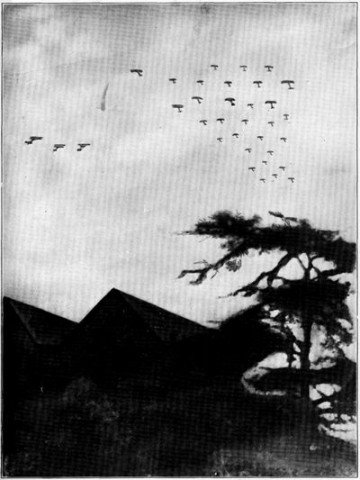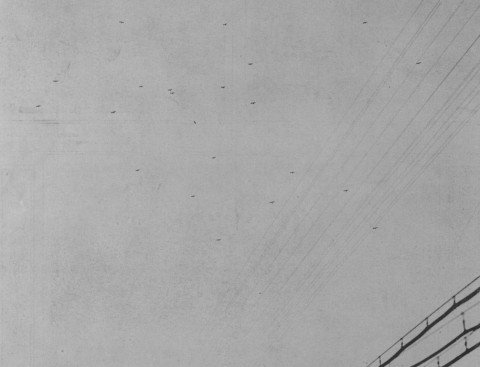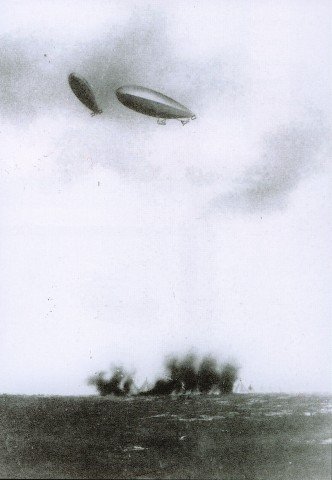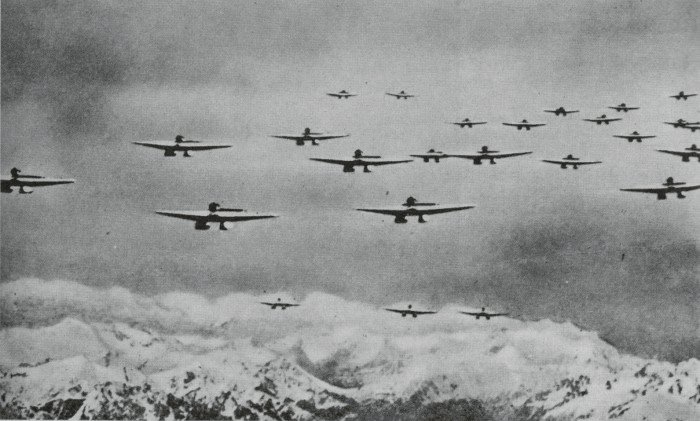N. A. J. Taylor recently asked me on Twitter if I thought the above photograph, purportedly of one of the daylight Gotha raids on London in 1917, was genuine.
I said no, due to 'Experience, intuition, lack of provenance, contemporary photographic technology. The photo has been retouched at very least.' But I'm coming around to the idea that it is real. A bit.

One problem is the ratio of the wingspans to the fuselage lengths. The Gotha G.IV had a very large wingspan for its length, almost twice as long as its fuselage: 77 feet to 40. The plan above (originally from Flight, 27 December 1917, 1380, though I got it from here). Looking at the little aeroplanes in the photograph in question, the ratio in general seems more like one to one than two to one. But the images are small, retouching might have altered the proportions, and the attitude of the aircraft could decrease the ratio (i.e. if they were banking). So that's not definitely definitive.
Another problem I had was provenance. There are a number of fake photographs of aerial combat and air raids from the First World War, as I have discussed before. Newspapers wanted to publish photos of such things, but photographic technology wasn't yet up to the task; after the war, too, there was a desire for images of the air war to illustrate books and magazines but where these weren't available they could be created.
So where did this photograph come from? The web page where it was found gives the source as a book called German Fighter Aces of World War One by Treadwell and Wood. I'm not familiar with it, but I do wonder why a book about German fighter aces would show a photo of German bombers. However I had seen it before somewhere, and it turns out I'd seen it in multiple places. It appears in Ian Castle, London 1917-18: The Bomber Blitz (Oxford and Long Island City: Osprey Publishing, 2010), 32, where the date is given as 7 July 1917 (so it's the second of the daylight Gotha raids on London) and the location is over Essex, on the return flight to Belgium. But no source is given. Those details also match Christopher Cole and E. F. Cheesman, The Air Defence of Britain 1914-1918 (London: Putnam, 1984), 263, where the source is given as the Public Record Office (as was). (They also reprint (262) diagrams of the Gotha formations from an Air Ministry 'publication' of October 1918, but it's not clear if that's their source for the photograph as well.) Cole and Cheesman do in fact consider the possibility that it isn't genuine, but conclude that this is improbable:
Newspapers generally printed crude montage pictures with aircraft scraping the rooftops, but this untidy formation is unlikely to have been faked.
Indeed, I've featured one such crude montage on this blog before:
You can see what Cole and Cheesman mean: this is far less convincing than the photograph in question here.
Getting back to the provenance, I've also found the photograph in books published much closer to the event in question. It's in Hamilton Fyfe, 'Winged killers in British skies', in John Hammerton, ed., War in the Air: Aerial Wonders of our Time (London: Amalgamated Press, n.d. [1936]), 190. Here at last there is an attribution, although not a proper citation: the photograph is credited to H. M. Stationery Office and is said to be 'an actual photograph in an official War Office report'. That's also pretty much what is said in the earliest source I've been able find: Joseph Morris, The German Air Raids on Britain 1914-1918 (Dallington: Naval and Military Press, 1993 [1925]), opposite 228. And Morris certainly did have the co-operation of the War Office and the Air Ministry in writing his book.
I haven't been able to locate a citation for this War Office report, but if that's where the photograph did come from then it seems unlikely to have been faked. Not because the War Office wouldn't lie, but because it's hard to see what the point would have been. If it was a confidential report, then presumably the goal was to disseminate accurate information about the raids; perhaps a montage for illustrative purposes would have been included but surely it would have been clearly labelled as such. If it was a public report, then why would they go to the trouble of faking a cloud of German bombers in the sky? Again, presumably they would want to dampen down fear, not enhance it.
So, the photograph itself still seems suspicious, but the provenance is firmer than I had thought. What do you think?
For the sake of completeness, here's another alleged photograph of the Gotha raid of 7 July 1917:
This one most definitely was taken (or made) at the time, as it appeared in the Illustrated London News, 14 July 1917, 38. It is credited to the 'Illustrations Bureau' (presumably the newspaper's own), and the caption is:
AS THOUSANDS SAW THE ENEMY: GERMAN "GOTHA" AEROPLANES OVER THE METROPOLITAN AREA
This could be a fake too, but its unspectacular nature perhaps stands against that.
Finally, here's another photograph of the second daylight Gotha raid:
The vantage point is slightly different than the other ones here, because it was actually taken from one of the Gothas. It's held by Imperial War Museum (Q 108954) but the original source was obviously a German airman. A couple of similar photographs (one actually showing a German bomber, though that doesn't prove anything) appear in Raymond H. Fredette, The Sky on Fire: The First Battle of Britain 1917-1918 and the Birth of the Royal Air Force (Washington, D.C.: Smithsonian Institution Press, 1991 [1966]. That's St Paul's in the lower left, and Finsbury Circus in the lower right.
![]() This work is licensed under a Creative Commons Attribution-NonCommercial-NoDerivatives 4.0 International License.
Permissions beyond the scope of this license may be available at http://airminded.org/copyright/.
This work is licensed under a Creative Commons Attribution-NonCommercial-NoDerivatives 4.0 International License.
Permissions beyond the scope of this license may be available at http://airminded.org/copyright/.








NAJ Taylor (@najtaylor)
Brett - thanks for taking the time to research this. It's a superb post in its own right.
It's interesting you found the precise same photo in a publication from the 1930s... What might this known first origin say about the possible scenarios as to whether the image is fake?
That is, I for one can think of questions relating to:
1. relative technology constraints at that time compared to now;
2. the academic credibility and known practices of the book's researcher as well as his tendency to source primary documents such as this incompletely as he has done here; and
3. what pressures and motives there might be at that time for the researcher, or others, to "fake" such as image.
That said, I am no historian so perhaps I'm off the mark with my line of questioning for your readers.
Brett Holman
Post authorNo, those are all very pertinent questions! I can't really provide good answers, though, for various reasons.
I'd have to do more research into the photographic technology of the time to see if photos like this were possible during WWI (e.g. are there other similar photos? what about of, e.g., flocks of birds?) But it is known that even highly-skilled photographers did create montages to 'represent' combat scenes, e.g. the Australian Frank Hurley. I don't think this was seen as fakery as it now would be, because photography was still in its infancy relatively speaking, it was acceptable to 'help' it along. (Of course today we have Photoshop, so we can't really talk anyway.)
On Morris's standard of referencing, his source attribution (or lack thereof) is about what I would expect for a work of this kind from this period, i.e. a popular history. I don't actually know a whole lot about Morris or how he came to write this book, but given the degree of help he had from official sources (War Office, Air Ministry, Imperial War Museum, Air Historical Branch) I think it should be regarded as a semi-official history. (The actual official history of the air war was in the middle of being published, the last volume didn't appear until 1935.)
On possible motivations for fakery, that's something that can't be answered until the author is known. I certainly don't believe Morris faked it, I think he did get it from the War Office. But where the War Office got it from, I don't know. They might have got it from an unimpeachable source, or they might have sourced it from a newspaper, which would have had a clear commercial motive for fakery: dramatic photos sell papers. Which again, doesn't mean they did in this case...
Jon
The first photo shows 20 aircraft, while the second has 22. The 7 July 1917 raid apparently consisted of 22 sorties. Is it plausible that one photo managed to capture every single aircraft that was dispatched in a fairly compact group, while the other photo captured nearly all of them?
It's possible, I guess. But it does suggest a potentially simpler method of figuring out whetehr the photos are genuine: Find the mission records from German sources to determine how many aircraft were actually dispatched and if any turned back early. If the photo contains more a/c than were ever over the Uk then: fake. What were the tactics used - did the Germans really try and fly these mobs of a/c in compact-ish formations, or were they all essentially free-running?
Also, you could look for eye witness reports and police records from London. Were the bombings compressed in time and space (which these photos would suggest) or were bombs coming down hours and many miles apart?
Brett Holman
Post authorGood ideas, Jon. In practice they don't help us to rule out either of the photos as genuine, though it could be that one of the captions is wrong. According to Cole and Cheesman, 27 Gothas set out on 7 July 1917; of these 22 crossed the Essex coast; and of these 21 went on to bomb London (1 had engine trouble and turned south to bomb Margate). After that they flew back to base via Essex. So the first photo, which I agree shows 20 aircraft, could have been taken at any point. I also got 22 for the second photo, which must mean it was taken in Essex on the inward journey, yet the caption claims it shows the bombers 'over the metropolitan area', which can't be right. But looking at it again, I wonder if one of the aircraft actually isn't? Nearly all of the aircraft have discernible wings and fuselages, and are more or less in flying in the same orientation. But the one a little above and to the left of the centre is different. It's either climbing/diving steeply and side-on to the camera, or facing towards/away from the camera and banking steeply. So actually I think this might be a bird or a flaw on the film. In that case there would be 21 and there's no problem.
Eyewitness accounts of the raid are also consistent with the photos. Here's how The Times described it (9 July 1917, 9):
This doesn't prove that the photos are real, either; many thousands of people watched the raid (hundreds of thousands, according to The Times) so there were a number of eyewitness accounts for a faker to draw upon, assuming they didn't see the Gothas themselves. But there's no real reason to conclude that they are fake -- I'm much less grudging about this than I was when I wrote this post!
Steve Kerry
After reading your comments of 15 Feb 2012 regarding the photo of 20 alleged Gotha bombers, I reached two conclusions: first, there are apparently 20 aircraft in the photo; second, they are definitely not Gotha bombers.
As a digital aviation artist, I set up an accurate model of a Gotha G.IV and used it to recreate the leading 7 aircraft. As you can see, the huge wingspan is unmistakable. The proportions of the aircraft in that photo are quite different which suggests they are fighters or perhaps 2-seaters?
Oh, it seems I can't attach my pic! You can find it here: http://www.metaphor.karoo.net/7Gothas.jpg
Cheers
Steve
Brett Holman
Post authorThanks for going to all that trouble! I agree that the ratio of fuselage to wingspan is the best argument against this photograph being real (or at least showing Gothas; though come to think of it I'm not sure I've seen any photographs of this many aircraft in the air from this period, which is another argument against it). But as I suggest in the post it could be that they are all banking (turning for home, perhaps) -- is that behaviour easy to reproduce in your model? (I'm probably too forgiving; I think at the least they have been retouched which means it's not really a 'real' photograph anymore anyway.)
Nick Beale
My copy of Cole & Cheeseman says 24 were dispatched (not 27) and 22 bombed. Also they caption the picture as showing 21 Gothas (as does Castle) and cite the untidiness of the formation as evidence that the shot is genuine. I'm inclined to agree with that (even though I know it isn't proof) because it looks how a bunch of aircraft trying to maintain or rejoin an intended formation would look. I suspect that a fake would have gone for serried parade-ground ranks of bombers because they'd want to give an air of menace and Prussian militarism. And was the photographic challenge that great? If the raid was at 12,000 feet and making (say) 60–70 mph then its passage overhead wouldn't exactly be fleeting.
Turning to the Heinkel, the Bundesarchiv details are at http://www.bild.bundesarchiv.de/cross-search/search/_1410194735/?search%5Bview%5D=detail&search%5Bfocus%5D=27
For non-German speakers, the photo is attributed to "Unteroffizier (nicht lesbar)" [Corporal illegible] of the Stabsstaffel KG 1 (HQ flight of Kampfgeschwader 1) and was issued by the HQ photographic section of Luftflotte [Air Fleet] 2. The date is 7.9.40 and a map reference is given (useful provided you have the right German map!) and the caption translates as: England, London. Aircraft Heinkel He 111 over industry and port installations on the Thames.
Nick Beale
Just to add that if anyone wants to do the work of correlating the smoke trails with the bombs, The Guardian published a spreadsheet and interactive map of the bomb incidents on 7 September 1940: http://www.theguardian.com/news/datablog/2010/sep/06/london-blitz-bomb-map-september-7-1940.
It might be possible from that to establish a timespan in which the He 111 photo could have been taken.
Brett Holman
Post authorYou're right, Cole and Cheesman says 24, not 27. Looking at their version (p. 263) of the photograph in question again, it's definitely the same as the one in this post (aircraft arranged in same untidy formation) BUT it's much more convincing -- the ratio of wing to fuselage is much more what I'd expect (i.e. about 2:1). The Gothas don't look as thick and in one or two cases I think I can make out the unusual staggered aspect at the end of the wings. It seems that some clumsy retouching has been going on in the version I've got here, perhaps to aid newspaper reproduction. (It looks like the same retouched version is in Morris, but it's so washed out in the facsimile edition I have that it's hard to be sure.) So, I was right to doubt this version, but the original photograph would appear to be genuine.
Regarding the Heinkel, you're on the wrong post. But that particular question has already been answered, and the original context is now known. (Though I don't think Chris has published on it yet.) Thanks for the Bundesarchiv link: it seems not possible to make a persistent link but anyone can find the photo from Nick's link by searching on heinkel and london.
David Nugus.
Further to the debate on the photograph "Am I fake or not - III".
I have an original copy of this photograph with a postcard back in a WWI postal history collection, the image has an inscription within the negative, which reads as follows - Photograph of German Aeroplanes which took part in raid on London, July 7th, 1917. Taken in Essex. Submitted by G. F. Quilter, Press Bureau passed as censored. 12th July 1917 . P.C.No 369.
Quilter was a professional photographer whose studio was in Ingatestone, Essex, so it is fair to assume it was taken in the vicinity of this small Essex town.
The image you show has been "cropped", my copy shows a further aircraft lagging some distance behind ( making 21 in all). As to provenance, my photograph has come down the generations through my late step - father, Frederick Nugus, who with his family lived at Ingatstone and knew Quilter. My postcard was published in "Gibbons Stamp Monthly" Letters, Vol 43 No 5. October 2012, in response to an article on the Royal Flying Corps by Ian Hamilton the previous May.
Brett Holman
Post authorThanks for that -- it's helpful to have a First World War provenance for the photo! As discussed in the comments, there are other versions which have not been retouched as heavily as this one appears to have been -- is your copy like that?
David Nugus
Some additional information as to the authenticity and integrity of the image of the Gotha raid of 7th July 1917. The "real photographic card" measures 140mm x 90mm overall, while the image measures 129mm x 79mm. The printed "Post Card" back is identical to others I have, family members etc. photographed by Quilter during the years 1914-1918.
At this time images were printed by hand from the original negative (often as few as a half dozen) on to stock photographic paper printed with a post card back, enabling the client to post them to friends and family.
I have examined the image using a digital microscope and can confirm there is no evidence of retouching, and have no doubt that the aircraft are Gotha's. It appears that the image used for publication was heavily "enhanced" and "bulked up" which totally altered the appearance of the aircraft.
Never having seen or heard of any other examples of the card, I would suggest it may not have been produced for sale in large quantities, but could have been given by Quilter to his clients as a souvenir of the raid.
Brett Holman
Post authorThanks again for your informative comment, which makes me realise (again) that I don't know much about the way that photographs were produced and distributed c. 1917! I had assumed that postcards like that would have been made in a factory (or 'factory'), but individual photographic studies making postcards on pre-printed backing in the way that you describe does makes sense.
Thanks also for the information about the lack of retouching. It does appear that it was retouched for publication, which of course was not uncommon where fine details were concerned; but it does look suspicious to our cynical modern eyes!